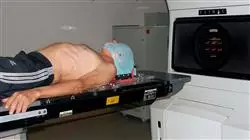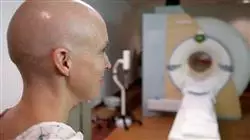University certificate
Scientific endorser

The world's largest faculty of medicine”
Introduction to the Program
You will master the most innovative radiotherapy techniques, refining dose planning and tumor response monitoring with this exclusive 100% online program”

The continuous progress of Radiation Oncology has solidified its role as one of the most relevant therapeutic strategies in modern cancer treatment. Thanks to these advancements, not only has the precision and effectiveness of procedures improved, but there is also a growing demand for highly trained professionals in the field. In addition, the integration of cutting-edge technologies and clinical approaches has driven the ongoing need for updated, specialized knowledge. As a result, ensuring the implementation of best practices based on the latest scientific evidence has become essential for the advancement of this discipline.
In response to this reality, TECH offers an innovative Professional master’s degree that provides in-depth training in the most advanced areas of Radiation Oncology. Through a carefully structured syllabus, the program covers everything from the biological foundations of cancer to the latest developments in precision Radiotherapy. Topics include intensity-modulated radiotherapy, image-guided radiotherapy, and stereotactic radiotherapy. As well as therapeutic indication criteria, treatment planning, and the use of new digital tools in radiotherapy practice—all aimed at delivering up-to-date, clinically relevant knowledge.
To ensure a flexible and effective learning experience, TECH offers a fully online methodology—accessible 24/7 from any device with an Internet connection. Through the innovative Relearning system, learners progressively assimilate key concepts, enhancing the development of clinical and technical skills.
Finally, a renowned International Guest Director will deliver 10 ground-breaking masterclasses on the latest advances inRadiation Oncology.
A renowned International Guest Director will give 10 comprehensive Masterclasses on the most recent advances in Radiation Oncology and their application in clinical practice”
This Professional master’s degree in Radiation Oncology contains the most complete and up-to-date university program on the market. Its most notable features are:
- The development of practical case studies presented by experts in Medicine
- The graphic, schematic, and practical contents with which they are created, provide scientific and practical information on the disciplines that are essential for professional practice
- Practical exercises where the self-assessment process can be carried out to improve learning
- Its special emphasis on innovative methodologies in the management of the audiovisual industry
- Theoretical lessons, questions to the expert, debate forums on controversial topics, and individual reflection assignments
- Content that is accessible from any fixed or portable device with an Internet connection
You will have access to updated content that will strengthen your clinical decision making skills, ranging from biological fundamentals to advanced radiation therapy techniques”You will have access to updated content that will strengthen your clinical decision making skills, ranging from biological fundamentals to advanced radiation therapy techniques”
The faculty includes medical professionals who bring their practical experience to the program, alongside renowned specialists from leading societies and prestigious universities.
The multimedia content, developed with the latest educational technology, will provide the professional with situated and contextual learning, i.e., a simulated environment that will provide an immersive educational experience designed to prepare students for real-life situations.
This program is designed around Problem-Based Learning, whereby students must try to solve the different professional practice situations that arise during the academic year. For this purpose, professionals will be assisted by an innovative interactive video system created by renowned and experienced experts.
You will explore how translational research and molecular biology transform cancer diagnosis and treatment in Radiation Oncology"

You will develop techniques in volumetric arc radiation therapy and adaptive planning to maximize efficacy"
Syllabus
This university program, distinguished by precision and innovation in Radiation Oncology, offers in-depth training in the foundations of radiotherapy, covering everything from the biological effects of radiation to its combination with pharmacological agents to enhance tumor response. It also explores the most advanced radiotherapy strategies for tumors of the central nervous system, head and neck region, thorax, and breast—incorporating cutting-edge techniques such as intensity-modulated radiotherapy (IMRT) and image-guided radiotherapy (IGRT). Through this training, participants will strengthen their ability to design personalized treatment plans that minimize side effects and improve patients’ quality of life.

You will plan advanced strategies to optimize Radiotherapy in Breast Cancer, applying adaptive planning to personalize treatment according to Tumor location and characteristics”
Module 1. Foundations of Radiotherapy Treatment. Radiobiology
1.1. Biological Effects of Ionizing Radiations
1.1.1. DNA Damage
1.1.2. Non-clonal Effects
1.2. Dose Fractionation
1.2.1. Linear-Quadratic Model
1.2.2. Time Factor in Radiotherapy
1.2.3. Altered Subdivisions
1.3. Oxygen Effect and Tumor Hypoxia
1.4. Radiobiology of Brachytherapy
1.5. Effects of Irradiation on Healthy Tissues
1.6. Combination of Irradiation with Drugs
1.7. Predictive Assays of Response to Radiotherapy
1.8. Radiobiology of Re-Irradiation
1.9. Effects of Irradiation on the Embryo and Fetus
1.10. Radiation-Induced Carcinogenesis
Module 2. Update of Radiotherapy Treatment in Central Nervous System Tumors (Adults)
2.1. Low-Grade Gliomas
2.2. High-Grade Gliomas
2.3. Benign Brain Tumors
2.3.1. Meningiomas
2.3.2. Vestibular Schwannoma
2.3.3. Neurinoma
2.4. Pituitary Tumors
2.4.1. Non-Functioning Adenomas
2.4.2. Prolactinoma
2.4.3. GH-Producing Adenoma
2.4.4. Cushing’s Disease
2.4.5. TSH-Secreting Adenomas, GnRH-Secreting Adenomas
2.4.6. Pituitary Carcinomas
2.5. Spinal Cord Tumors
2.5.1. Astrocytoma
2.5.2. Ependymoma
2.5.3. Meningioma
2.5.4. Chordoma
2.5.5. Chondrosarcoma
2.5.6. Miscellaneous Spinal Tumors
2.5.7. Spinal Cord Compression
2.5.8. Medulloblastoma
2.5.9. Craniopharyngioma
2.6. Orbital, Ocular and Optic Nerve Tumors
2.6.1. Rhabdomyosarcoma
2.6.2. Pineal Gland Tumors
2.6.3. Orbital Lymphoma
2.6.4. Ocular Melanoma
2.6.5. Ocular Metastases
2.6.6. Optic Nerve Glioma
2.6.7. Optic Nerve Meningioma
2.7. Primary Cerebral Lymphoma
2.8. Brain Metastases
2.9. Arteriovenous Malformations
Module 3. Update on Radiotherapeutic Treatment of ENT Tumors
3.1. Oral Cavity
3.1.1. Lip
3.1.2. Tongue
3.1.3. Floor of Mouth
3.1.4. Gum
3.1.5. Hard Palate
3.1.6. Retromolar Trigone
3.1.7. Jugal Mucosa
3.2. Oropharynx
3.2.1. Soft Palate
3.2.2. Tonsils
3.2.3. Oropharyngeal Wall
3.2.4. Base of the Tongue
3.3. Nasopharynx
3.4. Larynx and Hypopharynx
3.4.1. Larynx
3.4.1.1. Glottis
3.4.1.2. Supraglottis
3.4.1.3. Subglottis
3.4.2. Hypopharynx
3.4.2.1. Pyriform Sinus
3.4.2.2. Hypopharyngeal Wall
3.4.2.3. Postcricoid Tumors
3.4.3. Epidermoid Carcinoma Variants
3.4.3.1. Verrucous Carcinoma
3.4.3.2. Sarcomatoid Carcinoma
3.4.3.3. Neuroendocrine Carcinoma
3.5. Nasal and Paranasal Sinuses
3.5.1. Nasal Vestibule
3.5.2. Nasal Cavity and Ethmoid Sinus
3.5.3. Maxillary Sinus
3.6. Salivary Glands
3.7. Thyroid
3.7.1. Papillary Carcinoma
3.7.2. Follicular Carcinoma
3.7.3. Medullary Carcinoma
3.7.4. Anaplastic Carcinoma
3.7.5. Primary Thyroid Lymphoma
3.8. Cervical Lymph Node Metastases of Unknown Origin
Module 4. Update on Radiotherapeutic Treatment of Thoracic Tumors (Pulmonary, Pleural, Cardiac)
4.1. Non-Small Cell Lung Cancer
4.1.1. General Information on Non-Small Cell Lung Cancer
4.1.2. Early Stage Radiotherapy Treatment
4.1.3. Radical Radiotherapy Treatment in Locally Advanced Stages
4.1.4. Postoperative Radiotherapy Treatment
4.1.5. Palliative Radiotherapy Treatment
4.2. Small Cell Lung Cancer
4.2.1. Overview of Small Cell Lung Cancer
4.2.2. Thoraxic Radiotherapy Treatment in Limited-Disease
4.2.3. Radiotherapeutic Treatment in Extended-Disease
4.2.4. Prophylactic Cranial Irradiation
4.2.5. Palliative Radiotherapy Treatment
4.3. Uncommon Thoracic Tumors
4.3.1. Thymic Tumors
4.3.1.1. Overview of Thymic Tumors
4.3.1.2. Radiotherapeutic Treatment of Thymic Carcinoma
4.3.1.3. Radiotherapeutic Treatment of Thymomas
4.3.2. Carcinoid Lung Tumors
4.3.2.1. Overview of Carcinoid Lung Tumors
4.3.2.2. Radiotherapeutic Treatment of Carcinoid Lung Tumors
4.3.3. Mesothelioma
4.3.3.1. Overview of Mesotheliomas
4.3.3.2. Radiotherapeutic Treatment of Mesotheliomas (Adjuvant, Radical, Palliative)
4.4. Primary Cardiac Tumors
4.4.1. Overview of Cardiac Tumors
4.4.2. Radiotherapy Treatment of Cardiac Tumors
4.5. Pulmonary Metastases
4.5.1. Overview of Pulmonary Metastases
4.5.2. Definition of Oligometastatic Lung Status
4.5.3. Radiotherapeutic Treatment in Pulmonary Oligometastases
Module 5. Update on Radiotherapy Treatment in Breast Tumors
5.1. Introduction to Invasive Breast Cancer
5.1.1. Etiology
5.1.2. Epidemiology
5.1.3. Advantages of Screening: Overdiagnosis and Cost Overruns
5.1.4. Clinical and Pathological Staging
5.1.5. Radiological Diagnosis
5.1.6. Histological Diagnosis: Molecular Subtypes
5.1.7. Prognosis
5.2. General Information on Radiotherapeutic Treatment of Breast Cancer
5.2.1. Simulation Process: Positioning and Immobilization Systems
5.2.2. Image Acquisition and Volume Delimitation
5.2.3. Techniques: 3D-CRT, Evidence of IMRT/VMAT Use in Breast Cancer
5.2.4. Dosage, Fractionation and Constraints
5.2.5. Breath Hold
5.2.6. Image-Guided Radiation Therapy (IGRT)
5.2.7. Radiotherapy in the Presence of Cardiac Devices
5.3. Indications for Radiotherapy on the Breast After Conservative Treatment in Invasive Breast Cancer
5.3.1. Exclusive Preoperative Radiotherapy
5.3.2. Adjuvant Radiotherapy After Conservative Surgery and/or Primary Systemic Therapy
5.3.3. Evidence in Subdivisions
5.3.4. Better Conservative Treatment than Mastectomy?
5.3.5. Radiotherapy according to Molecular Subtype?
5.4. Indications for Radiotherapy after Mastectomy in Invasive Breast Cancer
5.4.1. Radiotherapy Post Mastectomy According to Type of Surgery
5.4.2. Radiotherapy Post Mastectomy in N0 Cancer Radiotherapy according to Molecular Subtype?
5.4.3. Radiotherapy Post Mastectomy in Complete Response After Primary Systemic Treatment
5.4.4. Rib Wall Hypofractionation
5.4.5. Inflammatory Carcinoma
5.5. Radiotherapy and Postmastectomy Breast Reconstruction
5.5.1. Types of Surgery (Radical Mastectomy, Skin-Sparing, Nipple-Areola Complex Preservation…)
5.5.2. Types of Reconstruction and Pros/Cons of Radiotherapy Before or After Reconstruction
5.5.3. Hypofractionation in Reconstructed Patients
5.6. Axillary Management for the Radiation Oncologist. Indication for Radiotherapy (RT) on Nodal Chains
5.6.1. Nodal Staging in Diagnosis and Sentinel Node Detection Methods
5.6.2. RT After Lymphadenectomy and After Positive Sentinel Gland at the Time of Surgery
5.6.3. RT After Sentinel Node Before/After Primary Systemic Therapy
5.6.4. Hypofractionation in Chains
5.6.5. Risk of Plexopathy
5.7. Boost: Indications and Radiotherapy Techniques
5.7.1. Rationale for the Implementation of the Boost
5.7.2. Indications After Conservative Surgery, Oncoplastic Surgery and Mastectomy
5.7.3. External Radiotherapy Techniques Simultaneous Integrated Boost (SIB)
5.7.4. Brachytherapy
5.7.5. Intraoperative Radiotherapy (IORT)
5.8. Partial Breast Irradiation: Indications and Radiotherapy Techniques
5.8.1. Justification for Performing Magnetic Particle Imaging (MPI)
5.8.2. Preoperative Radiotherapy
5.8.3. External Radiotherapy RTC3D. Intensity-Modulated Radiation Therapy (IMRT) SBRT
5.8.4. Brachytherapy
5.8.5. Intraoperative Radiotherapy (IORT)
5.9. Radiotherapy in Non-Invasive Carcinoma
5.9.1. Introduction
5.9.1.1. Etiology
5.9.1.2. Epidemiology
5.9.1.3. Advantages of Screening
5.9.2. Indications After Conservative Surgery and Evidence After Mastectomy
5.9.3. Genetic Platform in Ductal Carcinoma In Situ (DCIS)
5.10. Radiotherapy and Systemic Treatment
5.10.1. Concomitant Radiotherapy/Chemotherapy
5.10.1.1. Neoadjuvant
5.10.1.2. Inoperable
5.10.1.3. Adjuvant
5.10.2. Sequence with Systemic Treatment : Is it Possible to Administer Radiotherapy Before Chemotherapy After Surgery?
5.10.3. Radiotherapy and Hormonal Therapy (Tamoxifen, Aromatase Inhibitors): Evidence for their Sequential Administration: is Concomitance Better?
5.10.4. Chemotherapy Followed by Radiotherapy Without Surgery?
5.10.5. Association Radiotherapy and Anti-Her2 Teatment (Trastuzumab and Pertuzumab)
5.10.6. Possible Toxicities of the Association
5.11. Evaluation of the Response Monitoring Treatment of Locoregional Recurrences Reirradiation
5.12. Locoregional Radiotherapy in Metastatic Breast Cancer. Treatment of Oligometastases Stereotactic Body Radiotherapy (SBRT) Radiotherapy and Immunotherapy
5.13. Male Breast Cancer and Other Breast Tumors: Paget’s Disease; Phyllodes; Primary Lymphoma
Module 6. Update on Radiotherapy Treatment in Digestive Tumors
6.1. Esophageal Tumors
6.1.1. General Information on Esophageal Tumors
6.1.2. Radical Treatment of Cervical Esophageal Cancer
6.1.3. Radical Treatment of Thoracic Esophageal Cancer
6.1.4. Adjuvant Treatment of Thoracic Esophageal Cancer
6.1.5. Palliative Radiotherapy Treatment
6.2. Gastric and Gastroesophageal Junction Tumors
6.2.1. General Information About Gastric and Gastroesophageal Junction Cancer
6.2.2. Neoadjuvant Radiochemotherapy
6.2.3. Adjuvant Radiochemotherapy
6.2.4. Role of Radiotherapy in the Context of Perioperative Chemotherapy
6.2.5. Radical Radiochemotherapy
6.2.6. Palliative Radiotherapy Treatment
6.3. Pancreatic Tumors
6.3.1. Overview of Pancreatic Cancer
6.3.2. Role of Radiotherapy in Resectable Tumors
6.3.3. Role of Radiotherapy in Potentially Resectable Tumors (Borderline)
6.3.4. Role of Radiation Therapy in Unresectable Tumors
6.3.5. Role of Radiotherapy in Inoperable Tumors
6.3.6. Palliative Radiotherapy Treatment
6.4. Hepatobiliary Tumors
6.4.1. Overview of Hepatobiliary Tumors
6.4.2. Hepatocellular Carcinoma
6.4.3. Gallbladder Cancer
6.4.4. Cholangiocarcinoma
6.4.5. Liver Metastases
6.5. Colorectal Cancer
6.5.1. Overview of Colorectal Tumors
6.5.2. Neoadjuvant Treatment in Rectal Cancer
6.5.3. Adjuvant Treatment in Rectal Cancer
6.5.4. Radical Treatment in Rectal Cancer
6.5.5. Radiotherapeutic Treatment of Recurrences. Reirradiation
6.5.6. Role of Radiation Therapy in Colon Cancer
6.5.7. Palliative Radiotherapy Treatment
6.6. Anal Canal and Perianal Skin Cancer
6.6.1. Overview of Anal Canal and Perianal Skin Cancer
6.6.2. Role of Radiotherapy in Early Tumors and Carcinoma In Situ
6.6.3. Radical Treatment of Locally Advanced Tumors
6.6.4. Palliative Radiotherapy Treatment
Module 7. Update on Radiotherapy Treatment in Anesthesia Tumors
7.1. Endometrial Cancer
7.1.1. Epidemiological Aspects
7.1.2. Risk Factors
7.1.3. Anatomy Recap
7.1.4. Histological Type
7.1.5. Dissemination Pathways
7.1.6. Classification
7.1.7. Prognostic Factors
7.1.8. Surgical Treatment
7.1.9. Adjuvant Early Stage Radiotherapy Treatment
7.1.10. Advanced Disease
7.1.11. Local, Regional, Distant Recurrence
7.1.12. Monitoring
7.2. Uterine Sarcomas
7.2.1. Epidemiological Aspects
7.2.2. Risk Factors
7.2.3. Anatomy Recap
7.2.4. Histological Type
7.2.5. Dissemination Pathways
7.2.6. Classification
7.2.7. Prognostic Factors
7.2.8. Surgical Treatment
7.2.9. Adjuvant Early Stage Radiotherapy Treatment
7.2.10. Advanced Disease
7.2.11. Local, Regional, Distant Recurrence
7.2.12. Monitoring
7.3. Cervical Cancer
7.3.1. Epidemiological Aspects
7.3.2. Risk Factors
7.3.3. Anatomy Recap
7.3.4. Histological Type
7.3.5. Dissemination Pathways
7.3.6. Classification
7.3.7. Prognostic Factors
7.3.8. Surgical Treatment
7.3.9. Adjuvant Early Stage Radiotherapy Treatment
7.3.10. Advanced Disease
7.3.11. Local, Regional, Distant Recurrence
7.3.12. Monitoring
7.4. Vulvar Cancer
7.4.1. Epidemiological Aspects
7.4.2. Risk Factors
7.4.3. Anatomy Recap
7.4.4. Histological Type
7.4.5. Dissemination Pathways
7.4.6. Classification
7.4.7. Prognostic Factors
7.4.8. Surgical Treatment
7.4.9. Adjuvant Early Stage Radiotherapy Treatment
7.4.10. Advanced Disease
7.4.11. Local, Regional, Distant Recurrence
7.4.12. Monitoring
7.5. Vagina Cancer
7.5.1. Epidemiological Aspects
7.5.2. Risk Factors
7.5.3. Anatomy Recap
7.5.4. Histological Type
7.5.5. Dissemination Pathways
7.5.6. Classification
7.5.7. Prognostic Factors
7.5.8. Surgical Treatment
7.5.9. Adjuvant Early Stage Radiotherapy Treatment
7.5.10. Advanced Disease
7.5.11. Local, Regional, Distant Recurrence
7.5.12. Monitoring
7.6. Fallopian Tube and Ovarian Cancer
7.6.1. Epidemiological Aspects
7.6.2. Risk Factors
7.6.3. Anatomy Recap
7.6.4. Histological Type
7.6.5. Dissemination Pathways
7.6.6. Classification
7.6.7. Prognostic Factors
7.6.8. Surgical Treatment
7.6.9. Adjuvant Early Stage Radiotherapy Treatment
7.6.10. Advanced Disease
7.6.11. Local, Regional, Distant Recurrence
7.6.12. Monitoring
Module 8. Update on Radiotherapeutic Treatment of Prostate and Other Urological Tumors
8.1. Prostate Cancer
8.1.1. Low-Risk
8.1.2. Intermediate Risk
8.1.2.1. Definition of Intermediate Risk Prostate Cancer
8.1.2.2. Subclassification of Intermediate Risk Prostate Cancer
8.1.2.2.1. Importance of Gleason 7
8.1.2.3. Diagnosis and Extension Study
8.1.2.4. Treatment
8.1.2.4.1. Active Surveillance
8.1.2.4.2. Radical Prostatectomy
8.1.2.4.3. Radiotherapy. Techniques and Requirements
8.1.2.4.3.1. Role of External Radiation Therapy
8.1.2.4.3.2. Role of Brachytherapy
8.1.2.4.3.3. Role of Stereotactic Body Radiotherapy (SBRT)
8.1.2.4.3.4. Combined Treatments
8.1.2.4.4. Hormone Therapy. When and How Much?
8.1.2.4.5. The Best Option for Each Patient
8.1.2.5. Monitoring
8.1.2.6. Conclusions
8.1.3. High-Risk
8.1.4. Local and/or Distant Relapse Treatment
8.1.4.1. Treatment of Local Relapse
8.1.4.1.1. After Prostatectomy
8.1.4.1.2. After Radiotherapy
8.1.4.1.2.1. Rescue Surgery
8.1.4.1.2.2. Rescue Cryotherapy
8.1.4.1.2.3. Rescue Brachytherapy
8.1.4.1.2.4. High Intensity Focused Ultrasound (HIFU)
8.1.4.1.2.5. Intermittent Hormone Rescue
8.1.4.2. Treatment of Distant Relapse
8.1.4.2.1. Metastatic Patient
8.1.4.2.2. Oligorecurrent Patient
8.1.4.2.2.1. Hormonal Treatment
8.1.4.2.2.2. Surgical Treatment
8.1.4.2.2.3. SBRT Treatment
8.2. Preoperative and Postoperative Radiotherapy in Bladder Cancer
8.2.1. Introduction
8.2.2. Preoperative Radiotherapy
8.2.2.1. Bibliographic Review
8.2.2.2. Indications
8.2.3. Postoperative Radiotherapy
8.2.3.1. Bibliographic Review
8.2.3.2. Indications
8.2.4. Organ Conservative Treatment
8.3. Testicular Tumors
8.3.1. Introduction
8.3.2. Histological Type
8.3.3. TNM Classification and Prognostic Groups
8.3.4. Germinal Tumors: Treatment According to Stage and Prognostic Group
8.3.4.1. Seminoma
8.3.4.2. Non-Seminoma
8.3.5. Toxicity of Chemotherapy and Radiotherapy
8.3.6. Secondary Neoplasms
8.3.7. Non-Germ Cell Tumors
8.4. Renal, Ureteral and Urethral Tumors
8.4.1. Renal Tumors
8.4.1.1. Clinical Presentation
8.4.1.2. Diagnosis
8.4.1.3. Localized Disease Treatment
8.4.1.4. Advanced Disease Treatment
8.4.2. Urethral Tumors
8.4.2.1. Clinical Presentation: Men vs. Women
8.4.2.2. Diagnosis
8.4.2.3. Treatment
8.4.3. Ureter and Renal Pelvis Tumors
8.4.3.1. Risk Factors
8.4.3.2. Presentation: Primary Tumor-Metastasis
8.4.3.3. Symptoms/Clinical
8.4.3.4. Diagnosis
8.4.3.5. Localized Disease Treatment
8.4.3.6. Advanced Disease Treatment
8.5. Penile Cancer
8.5.1. Adjuvant Treatment
8.5.2. Radical Treatment
8.6. Treatment of Adrenal Metastases
8.6.1. Introduction
8.6.2. Surgery
8.6.3. SBRT
Module 9. Update on Radiotherapy Treatment in Low Incidence and Miscellaneous Tumors
9.1. Orbital and Ocular Tumors
9.1.1. Orbital Tumors
9.1.1.1. Rhabdomyosarcoma
9.1.1.2. Lacrimal Gland Tumors
9.1.1.3. Orbital Metastases
9.1.1.4. Orbital Pseudotumor
9.1.1.5. Graves-Basedow Ophthalmopathy
9.1.2. Ocular Tumors and Ocular Pathology
9.1.2.1. Choroidal Melanoma
9.1.2.2. Choroidal Metastasis
9.1.2.3. Primary Ocular Lymphoma
9.1.2.4. Pterigyum
9.1.2.5. Macular Degeneration
9.1.2.6. Choroidal Hemangioma
9.2. Cutaneous Tumors
9.2.1. Melanoma
9.2.2. Non-Melanoma Skin Tumors
9.2.2.1. Basal Cell Carcinoma
9.2.2.2. Squamous Cell Carcinoma
9.2.2.3. Merckel Cell Carcinoma
9.2.2.4. Adnexal Carcinomas
9.3. Soft Tissue Sarcomas and Bone Tumors
9.3.1. Soft Tissue Sarcomas of the Extremities and Trunk
9.3.2. Retroperitoneal and Pelvic Sarcomas
9.3.3. Head and Neck Sarcomas
9.3.4. Dermatofibrosarcoma Protuberans
9.3.5. Desmoid Tumor
9.3.6. Bone Sarcomas
9.3.6.1. Ewing Sarcoma
9.3.6.2. Osteosarcoma
9.3.6.3. Chondrosarcoma
9.3.6.4. Chordoma
9.4. Hematological Tumors and Associated Techniques
9.4.1. Hodgkin’s Lymphomas
9.4.2. Non-Hodgkin’s Lymphomas
9.4.3. Multiple Myeloma
9.4.4. Plasmacytoma
9.4.5. Mycosis Fungoides
9.4.6. Kaposi’s Sarcoma
9.4.7. Total Body Irradiation, Total Nodal Irradiation
9.5. Pediatric Tumors
9.5.1. Central Nervous System Tumors
9.5.2. Soft Tissue Sarcomas
9.5.3. Bone Sarcomas
9.5.4. Wilms Tumor
9.5.5. Retinoblastoma
9.5.6. Neuroblastoma
9.5.7. Leukemias and Lymphomas
9.6. Benign Pathology
9.6.1. Benign Joint and Tendon Diseases
9.6.2. Benign Connective and Skin Diseases
9.6.2.1. Keloids
9.6.2.2. Plantar Fasciitis
9.6.2.3. Gynecomastia
9.6.3. Benign Bone Tissue Diseases
9.6.3.1. Heterotopic Ossification
9.6.3.2. Vertebral Hemangiomas
9.6.3.3. Pigmented Villonodular Synovitis
9.6.3.4. Aneurysmal Bone Cyst
Module 10. Pain and Nutrition in Radiation Oncology
10.1. General Information on Oncologic Pain
10.1.1. Epidemiology
10.1.2. Prevalence
10.1.3. Impact of Pain
10.1.4. Multidimensional Concept of Cancer Pain
10.2. Characterization of Pain
10.2.1. Types of Oncologic Pain
10.2.2. Evaluation of Oncologic Pain
10.2.3. Prognosis of Pain
10.2.4. Classification
10.2.5. Diagnostic Algorithm
10.3. General Principles of Pharmacological Treatment
10.4. General Principles of Radiotherapy Treatment
10.4.1. External Radiotherapy
10.4.2. Dosages and Fractions
10.5. Bisphosphonates
10.6. Radiopharmaceuticals in the Management of Metastatic Bone Pain
10.7. Pain in Long-Term Survivors
10.8. Nutrition and Cancer
10.8.1. Concept of Malnutrition
10.8.2. Prevalence of Malnutrition
10.8.3. Causes and Consequences of Malnutrition in Oncology Patients
10.8.4. Mortality and Survival
10.8.5. Nutritional Risk Factors in Oncology Patients
10.8.6. Objectives of Nutritional Support
10.9. Cachexia
10.10. Initial Nutritional Assessment in a Radiation Oncology Service
10.10.1. Diagnostic Algorithm
10.10.2. Specific Treatment
10.10.3. General Dietary Recommendations
10.10.4. Specific Individualized Recommendations
10.11. Nutritional Assessment During Monitoring in a Radiation Oncology Service

A unique, key and decisive educational experience to boost your professional development”
Master's Degree in Radiation Oncology
Radiological studies have long represented a significant tool in the treatment of neoplasms and multiple types of cancerous diseases. Faced with the gradual evolution of ionizing radiation, an update in its modus operandi is required, especially for those physicians who wish to help cancer patients. Focused on this action, TECH Global University has developed the Master's Degree Radiation Oncology: a postgraduate degree that breaks down both specific biological assessments and clinical cases on one of the most widely used anticancer procedures in the hospital sector. Using prestigious academic methodologies and online classes based on the latest advances in educational telematics, we offer you an exclusive complement to your career. Being highly knowledgeable of the healthcare labor market, we have pondered the growth possibilities that specialists have in specific fields of application. Oncology with a radiological focus is one of those areas that will help boost your career in the medical profession. With TECH, you are on your way to the professional life you desire.
Study oncology and radiation therapy with this master's degree
One of the biggest fears for anyone is hearing the terms cancerous tumor or metastasis after a medical diagnosis. The fear is well-founded. According to WHO data, in 2020 alone, nearly ten million people died of some type of cancer. The good news is that different advances and studies in the field of biomedicine and biotechnology have come to show that the correct treatments can cure up to 90% of patients diagnosed with neoplasms, as stated in an article in the newspaper El Imparcial. Under this approach, our postgraduate degree is a more than promising alternative in the fight against cancer. Here you will learn from the basics and use of radiotherapy treatment for various types of tumors to topics such as nutrition and pain management. All in self-regulated online classes with advanced multimedia content. We encourage you to enroll and explore a new form of professionalization that will take your practice to another level.







